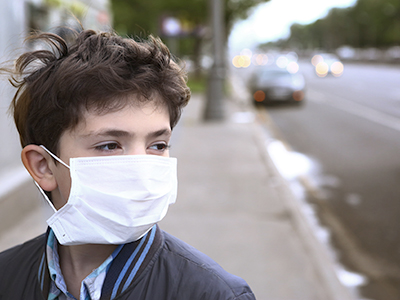
Traffic pollution still harming Canadian kids despite improved emission standards.
A new study of traffic pollution and asthma shows Canada has higher rates of new childhood asthma cases than most of the world. While air pollution is generally worse in other countries like China and India, the study ranks Canada third in the world for rates of new childhood asthma cases caused by vehicle emissions.
Vancouver Coastal Health Research Scientist Dr. Michael Brauer co-authored the study, recently published in the journal Lancet Planetary Health. Brauer says a combination of factors explains the rankings. “We don’t tend to think of Canada as highly polluted—and it’s not. We are cleaner, but not by much, when it comes to traffic pollution," says Brauer. "Compared to most other countries, we have a lot of cars in Canada. And, most Canadians live in cities. When you put those two things together—you get congestion and a higher amount of this kind of pollution.”

Brauer says that while overall air pollution might be worse in other places, Canadians are likely more susceptible to its impacts on asthma development because of other factors, such as our heavier use of antibiotics, our hygienic lifestyles and our high rates of C-sections. All of these things have strong links to childhood asthma. Brauer says a country like India—known to be very polluted—has lower rates of asthma than Canada. “We believe it’s related to all those other risk factors, as well as dietary factors. In countries with lower asthma rates, immune systems are different and develop differently than ours.”
“Many people might not realize that asthma is generally a disease of high-income countries. It’s a disease that tracks with high economic development.”

Another important distinction is that more than a third of Canadians live near a major roadway. Despite huge vehicle emission improvements over the last 30 years, Brauer says the air we breathe is still harmful, with children aged five and under being the most susceptible to developing asthma.
Better urban planning to protect children
Brauer says urban planners and municipal politicians need to take children’s health into consideration when deciding where to allow daycares, schools and housing to be built.

Brauer recommends following the lead of places like California where laws mandate that schools be built further away from freeways to reduce children’s exposure to air pollution. Given the health care costs of asthma—estimated at more than $2 billion a year in Canada—Brauer says it’s well worth the effort to take action.
Beyond zoning, Brauer says there needs to be more emphasis on cleaner modes of transportation, including transit, cycling and walking.
"If we can improve the air in our cities through cleaner transportation, we could cut new asthma cases by up to 20 per cent. That’s worth doing.”
But since BC’s AirCare program—which tested and monitored vehicle emissions—was ended in 2014, Brauer believes it is unlikely traffic pollution levels will decrease further without more dramatic government intervention.
“Basing policy on current emission standards is not effective enough,” says Brauer. “If we can move to cleaner transportation, it will have positive impacts on other health conditions and on tackling climate change.”


